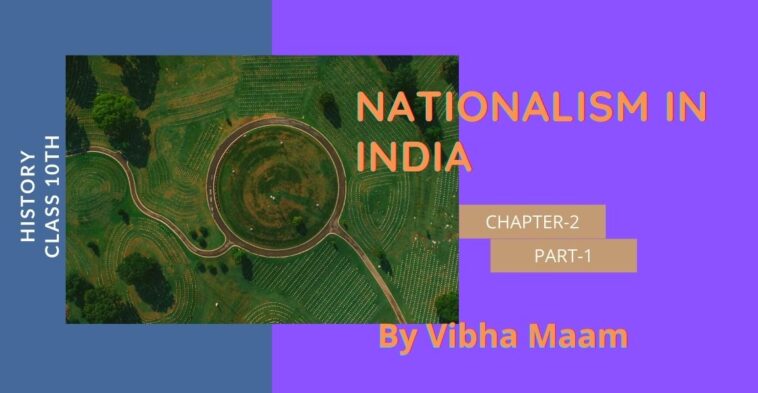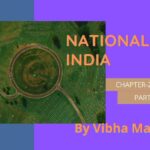Checkout handpicked notes of NCERT class 10th History Chapter 2 Part 1 Nationalism in India notes by Vibha Madam and don’t forget to share your valuable comments in the comment below to motivate our author.
Nationalism in India Notes by Vibha Maam
The First World War, Khilafat and Non- Cooperation
- Created economic and political situation
- Increase in defence expenditure
- Prices increase doubling between 1913 and 1918 leading to extreme hardship for the common people
- Forced recruitment of rural people in army, spread anger among people
- Crop failure in many parts of India
- Leading to shortages of food
- Spread of an influenza epidemic, killing millions of people
The Idea of Satyagraha
Emergence of Gandhi ji 1915 with the idea of Satyagraha and non-violence
Three experiment of Gandhiji with Satyagraha :-
- 1917 – Champaran, Bihar against the oppressive plantation system.
- 1917 Kheda, Gujarat demanding relaxation in revenue collection
- 1918 Ahmedabad, Gujarat in support of cotton mill worker
The Rowlatt Act (1919)
- It was passed by the Imperial Legislative Council without support of Indian members.
- the government got power to detain political prisoners for two years without any trial.
- It was intended to curb political activity by Indians. Gandhiji launched a non-violent civil disobedience movement starting with hartal.
Result of CDM
- Massive strike and shut down shops and workshops
- On 10th April police fired upon a peaceful procession
- Imposition of martial law by general Dyer.
Jallianwala Bagh Tragedy (13th April 1919)
- Unaware of martial law, people in Amritsar gathered in Jallianwala Bagh on 13th April to celebrate Baisakhi.
- General Dyer blocked the only exit and ordered fire on the gathering, killing hundreds to create terror.
- News spread in North India , public reaction took a violent turn
- The government responded with brutal repression, humiliated protesters.
- Violence forced Gandhiji to call off the Satyagraha movement (CDM)
Khilafat and Non- cooperation movement
- The First World War has ended with the defeat of Ottoman Turkey.
- Gandhiji intended to unite people specially Hindu and Muslim for a wider movement across India.
- To defend the Khalifa’s temporal power, a Khilafat committee was formed in Bombay in March 1919 by Mohammed Ali and Shaukat Ali.
- At the Calcutta session of Congress in September 1920, a resolution was passed to launch a Non-cooperation movement in support of Khilafat as well as for Swaraj.
Non- Cooperation Movement
Mahatma Gandhi declared in his famous book ‘Hind Swaraj‘ that British rule was established in India with the cooperation of Indians.
If Indians refused to cooperate, British rule in India would collapse within a year, and Swaraj would come.
Stages of Non-cooperation movement (NCM)
- Surrender of government titles, boycott of civil services, schools, colleges, police, court, legislative councils, foreign goods.
- If the government uses repressive measures, a CDM campaign will be launched.
- Finally, at the congress session at Nagpur in December 1920, Non-cooperation program was adopted.
Differing strands within the movement
The Non Cooperation – Khilafat movement began in January 1921, various social groups participated, each group with its own specific aspiration.
The movement in the towns:
Thousands of students left government schools and colleges, lawyers gave up legal practices, foreign goods were boycotted, liquor shops picketed, foreign clothes burnt in huge bonfires.
Slowdown the momentum of NCM because:-
- Khadi was expensive
- Absence of alternative
- Students, teachers, lawyers joined back government schools and offices.
Rebellion In countryside
In Awadh by Peasants:
- Led by Baba Ramchandra
- Movement against landlord and taluqdars
- Panchayat organised ‘nai- dhobi bandhs’
- setting up of ‘Oudh Kisan Sabha’ with branches in many villages by Jawaharlal Nehru and Baba Ramchandra and a few others.
- As movement spread in 1921, the houses of merchants and taluqdars were attacked, bazaars were looted and grain hoards were taken over.
In Andhra Pradesh by Tribals:
- In the Gudem hills, a militant guerrilla movement spread in the early 1920s led by ‘Alluri Sitaram Raju‘ against forest laws
- They used violence against British officials.
- Raju persuaded people to wear khadi and give up drinking.
- Raju was captured and executed in 1924.
Swaraj in the plantation
In Assam by plantation workers:
- Inland Emigration Act 1859, opposed by plantation workers.
- Workers were not permitted to leave plantations.
- When they heard of NCM, many workers defied authorities and headed home.
- They were caught and brought back to the plantation and given brutal treatment.
Withdrawal of Non- Cooperation Movement (NCM)
In 1922, at Chauri-Chaura in Gorakhpur ,a peaceful procession turned violent, in which 22 policemen were burnt alive. hearing this violence Gandhiji called off the NCM in February 1922.
Don’t forget to comment in the comment section below to appreciate and motivate our author by sharing this notes with your friends you can also Contact us for any query or if you are interested in writing with us.
Use Canva for amazing images.
Stay tuned for more amazing stories, poems & articles like this.
For sponsor any article or your article you can mail us with your logo ready and details.











Thanku mam for these notes.
excellent notes
fabulous
Good work
Keep it up
Good job😍😍
Nice notes mam/ sir this notes very helpful for me and many people once again thanks ❣️❣️🥰🥰✨✨
Pls make full chapter notes. It’s so long .
These notes are not full
Please make them more detailed and please make full chapter notes
There is a part 2 of this chapter also available
Kindly check the link for reference
https://blogscart.in/nationalism-in-india-part-2/
This is not complete plz complete chapter
Part 2 of this chapter is also available
Kindly check the link for reference
https://blogscart.in/nationalism-in-india-part-2/